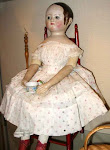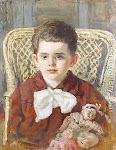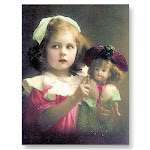 During the Victorian era and into the early 20th century the history of dolls was connected with the lives of the middle class and wealthy children who would have owned them. Its my purpose in creating this blog to portray dolls which mark the stages of developing history. But regrettably, of the Victorian period, only a few items remain from the rag and bone toy box of the very poor. Underprivileged children of the time, were forced to make do with whatever lay at hand; A mutton bone, wrapped in a rag, would make a much loved doll for a poor child.
During the Victorian era and into the early 20th century the history of dolls was connected with the lives of the middle class and wealthy children who would have owned them. Its my purpose in creating this blog to portray dolls which mark the stages of developing history. But regrettably, of the Victorian period, only a few items remain from the rag and bone toy box of the very poor. Underprivileged children of the time, were forced to make do with whatever lay at hand; A mutton bone, wrapped in a rag, would make a much loved doll for a poor child.As doll-making art is predominantly from the Victorian and Edwardian periods, these dolls are the more procurable by collectors. Mass production methods were becoming commonplace by the end of the century, so a large number of dolls of all different types were surfacing at the same time.
In this post I will show only samples of China, and Bisque including the beautiful French Bebes, and Fashion Dolls. All of these dolls will be covered individually in later chapters including their makers.
For now, my objective is to show that these dolls were available at the time of Queen Victoria’s reign, but only to the very wealthy.

"Dollmaker"
Wax Dolls
In addition to wooden dolls, wax dolls were popular in the 17th and 18th centuries, and they were also a contemporary of the papier mâché doll. . Munich was a major manufacturing center for wax dolls, although the earliest wax dolls found by collectors tend to be the poured wax dolls made in England. This was after the demise of the wooden doll industry from 1840 through the remainder of the 19th century. Although pressed wax dolls were made before this time for the very wealthy.
The Young Queen Victoria became a symbol of the 1840’s subdued and dove-colored decade. She spent her time most domestically filling the palaces with nurseries. It was in this quiet and rather dowdy atmosphere that the early porcelain dolls made their debut.
 Conta Boheme China doll ca. 1870. Elaborately styled hair. Wears hand-sewn lawn white dress with antique lace.
Conta Boheme China doll ca. 1870. Elaborately styled hair. Wears hand-sewn lawn white dress with antique lace. Kestner China Doll with "Covered Wagon" hairstyle from my own collection... ca. 1860. Original antique dress, original cloth body with individually stitched fingers.
Kestner China Doll with "Covered Wagon" hairstyle from my own collection... ca. 1860. Original antique dress, original cloth body with individually stitched fingers. Germany, France and Denmark started creating china heads dolls in the 1840's they are often identified by their hairstyles.
Germany, France and Denmark started creating china heads dolls in the 1840's they are often identified by their hairstyles. Child portrait with a "Lowbrow "China head doll ca. 19th century
Child portrait with a "Lowbrow "China head doll ca. 19th century Parian Dolls
If there is no color added to the bisque and it is left white and unglazed, the doll is sometimes referred to as a "Parian" doll.
 Alt Beck Gottschalk...Lady Parian with Blue Scarf. Antique lace dress, pierced ears ca. 1880
Alt Beck Gottschalk...Lady Parian with Blue Scarf. Antique lace dress, pierced ears ca. 1880
The best known group of antique dolls are the German and French bisque dolls. Bisque, which is fired twice with color added to it after the first firing, looked more like skin than china.
The years from 1860 through 1890 were dominated by fashion dolls. These dolls were made to represent ladies, and they were dressed in exquisite, elaborate reproductions of current fashions.

 Stunning Bru Bebe, notice the huge almond shape eyes. Jumeau and Bru dolls are noted for their beautiful faces. ca. 19th century French Bebe.
Stunning Bru Bebe, notice the huge almond shape eyes. Jumeau and Bru dolls are noted for their beautiful faces. ca. 19th century French Bebe.













































.jpg)




















































































Fantastic information and the pictures are wonderful, thank you so much for researching Marta, I really am enjoying all this history.
ReplyDeletesiempre me gustan tus entradas, pero esta.....has tocado uno de mis puntos debiles,me encantan!!!!!todas son preciosas pero las Jumeau, para mi, son ¨la joya de la corona¨supongo que me entiendes , y ademas una explicacion muy buena, besos
ReplyDeleteHi Marta, The Bru bebe dolls are so beautiful! And the workmanship on the one wax doll is unbelivable. Thanks for the information...Julian
ReplyDeleteThank you so much for your wonderful comments. It makes it all worthwhile.
ReplyDeleteBisous
Marta
Muy buena información, como siempre!!1
ReplyDeleteLas muñecas de cera... creo que me gustaban más antes de ver este bebé, tan... tan difunto.
a great post with a lot of wonderfull pictures, thanks for your investigation and demonstration Marta :)
ReplyDeleteBeautiful post, Marta.
ReplyDeleteMe sorprende que estas muñecas fabricadas con esos materiales, aparentemente tan frágiles, hayan sobrevivido hasta hoy. I love the fashion dolls. Las que representan adultos, con esos maravillosos vestidos en miniatura. And what can I say about those tiny borzois! You know me...
By the way, the one doll of your own collection, it´s very sweet. To own one of those dolls it must be like to own a relic!
Well done, Marta!
Thank you! I love your posts.
Besos.
Thank you Alberto, you are so kind. I knew you'd like the Borzois.
ReplyDeleteYes...my "Covered Wagon China" is very old and all original. She is a big girl too, 26".
Bisous
Marta
Oh Marta I've missed reading your blog while I was away!! It is a breath of fresh air!
ReplyDeleteGreat post as always. You lucky lucky lady to own that magnificent Kestner China and in her original clothing no less!! AHHHHH I'm green with envy, lol!!
Hugs,
Nan
Son preciosas.. por cierto me encanta la música de tu blog.
ReplyDeleteBesitos
Tienes un meme en mi blog igual te apetece hacerlo.
ReplyDeleteBesos
Wonderful! Love the old photos.
ReplyDeleteThank you all so much for the encouraging comments. Sometimes I feel my posts are too long, but I like to cover as much of the history as possible. Any feedback you have will be most appreciated.
ReplyDeleteBisous
Marta
Goodmorning Marta, Thank's for telling me the name of the vine and also your vist. I will try and get some rest. But it seems I always find my self wanting to go outside and do some weeding or a little something. Have a good weekend...Julian
ReplyDeleteHola Marta!!!
ReplyDeleteHe quedado anonadada con las imágenes de tu blog...no así con el idioma...cuánto te agradecería que instales un traductor para poder leer sobre algo que me apasiona.
Dese ya muchas gracias.
Un abrazo desde Tandil, Argentina
Querida Maria Cristina, cuanto te agradesco sigas mi blog. He querido instalar un translador, pero no he podido tener exito.
ReplyDeleteMuchas gracias por tu comentario, y tratare de resolver este problema.
Un beso muy grande
Marta
Mil gracias Marta!!!
ReplyDeleteDe a poco iré leyendo tus post, este me ha resultado muy ameno e interesante...y gracias por aceptar mi sugerencia.
Un abrazo y mis cariños!
Muy buen fin de semana!
My goodness, that first doll was so lifelike! I have an antique china head doll--but sadly, only the head. I attached her to a reproduction body and I just love her!
ReplyDeleteThank you Heidi for your comment!You will find a lot of china head dolls with newer bodies. Its not unusual. Sometimes the little owner of such a doll would fell ill, and take her dollie to bed with her. After the illness passed mother would usually burn the cloth body and make a new one to attach the head too. I am sure your doll is beautiful!
ReplyDeleteHugs
Marta
Great job, Marta! All beautiful to look at. Queen Victoria was born in 1837 and it's a wonderful thing that she so enjoyed her dollies during those 1840's. She particularly loved a rather large collection of little "penny woodens". In spite of all their beauty, the "fancy" dolls for the rich, I still prefer the pathetic little, cloth attempts of the not so rich. I'll be looking forward to that post too!
ReplyDeleteChristine
I found a doll really old embedded in my great grandmothers adobe house wall when we tore it down it stands about 2ft tall its hard hard plastic has no hair and no clothes but it has a bone clenched in its hand would you know anything about this type of old doll? you can email me back at babytiger64@hotmail.com
ReplyDelete